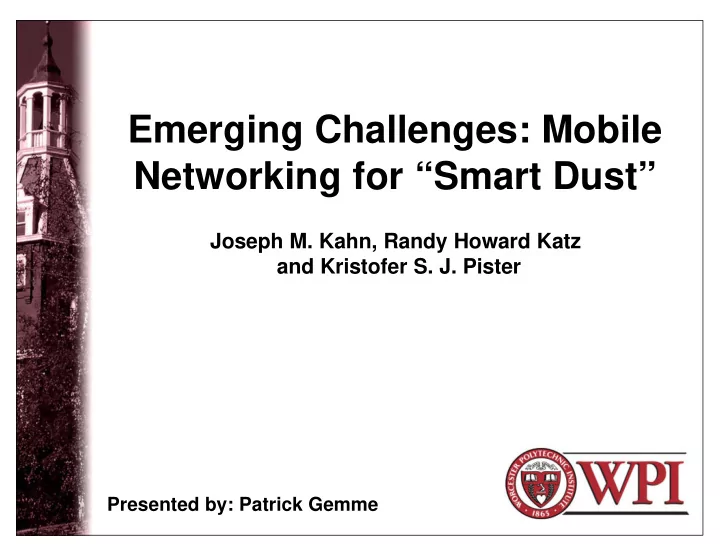

Emerging Challenges: Mobile Networking for “Smart Dust” Joseph M. Kahn, Randy Howard Katz and Kristofer S. J. Pister Presented by: Patrick Gemme
Overview • Focus • Hardware • Challenges • Technology • Applications • Related Project • Conclusions 2 Worcester Polytechnic Institute
Focus • Large scale network of Wireless sensors are becoming more and more plausible • Networking and application layers are needed to make such a system usable. 3 Worcester Polytechnic Institute
Hardware • Can now integrate sensing, communication, and power supply into an inch-scale device. (off-the-shelf) • 3 technologies leading this advance: – Digital circuitry – Wireless communications – Micro ElectroMechanical Systems (MEMS) 4 Worcester Polytechnic Institute
Key Challenges • Must consume extremely low power • Must communicate at average bit rates measured in kilobits p/sec • Must operate in high volumetric densities • How? – Needs ad hoc routing – Media Access solutions 5 Worcester Polytechnic Institute
Smart Dust mote 6 Worcester Polytechnic Institute
Energy • Total Stored energy is on the order of 1 J – If that is consumed continuously over a day, then the dust mote power consumption cannot exceed roughly 10mW • Solar cells could gain about 1 J per day in the sun • Energy-optimized microprocessors user about 1 nJ per 32-bit instruction – Bluetooth burns about 100nJ per bit transmitted – Picoradios Picoradios target 1nJ/bit –which will allow billions of – operations per Joule 7 Worcester Polytechnic Institute
Ultra-low power: RF or Optical • RF cons: – Extremely short-wavelength transmission – Energy Issues • Difficult to reduce to such low power consumption • Optical Cons: – Line-of-sight needed (within a few tens of degrees) 8 Worcester Polytechnic Institute
Optical Pros • High antenna gain can be achieved with very low power • A base-station can decode simultaneous transmissions with Space-division multiplexing • Passive optical transmission – No optical power needed • Corner-Cube Retroreflector (CCR) 9 Worcester Polytechnic Institute
Achieves several kilobits per second over hundreds of meters in full sunlight At night it should extend to at least a kilometer 10 Worcester Polytechnic Institute
Line-of-sight? • Receiver is fairly omni-directional (forget about it) 1. With one CCR a mote has about a 10% chance of being able to transmit to BTS – Equip it with several CCRs 2. Distribute an excess number of motes (expecting many to not be able to communicate) 3. Steer the Beam in the right direction 11 Worcester Polytechnic Institute
MAC protocol • Sensor-MAC (S-MAC) • Etiquette Protocol • CSMA for Sensor Networks • Z-Mac 12 Worcester Polytechnic Institute
Passive and Broadcast-oriented techniques • A single wide beam from BTS can simultaneously probe many dust motes • Motes transmit in short-duration burst signals – similar to cell phones • BTS grants channels to requesting nodes • There are as many channels as resolvable pixels at the BTS 13 Worcester Polytechnic Institute
Applications • Used to record data for meteorological, geophysical or planetary research • Environments where wired do not work • (semiconductor processing chambers, rotating machinery, wind tunnels, anechoic chambers) • Biological: • Measure movements, habits, and environments of insects and small animals • Military: • (passage of vehicles, perimeter surveillance, chemicals) 14 Worcester Polytechnic Institute
Operate in Ensembles • Sensors can specialize in certain signatures and combine for more useful information – A change in temperature may not mean much – A change in sound level probably doesn’t tell us enough – Movement could mean many things • The combined array through P2P could determine that a vehicle just pulled up with at least 2 men 15 Worcester Polytechnic Institute
Why is Ad hoc needed? • The centralized/passive scheme is most power efficient way to communicate. • Line-of-sight (again) – The mote will have to use Ad hoc if line-of-sight to BTS is not possible – Requires 4 phase handshake • Standard routing algorithms like RIP, OSPF, and DVRMP assume bidirectional and symmetric links – New routing algorithms must be able to deal with unidirectional and/or asymmetric links 16 Worcester Polytechnic Institute
Related Projects • Factoid Project at Compaq Palo Alto Western Research Laboratories • Wireless Integrated Network Sensors (WINS) Project at UCLA • Ultralow Power Wireless Sensor Project at MIT 17 Worcester Polytechnic Institute
Summary and Conclusions • “Smart Dust” has described an inexpensive way to setup small low power sensors which can communicate to a central BTS and/or each other • Attacked the line-of-sight issue with 3 possible solutions • Opened up leads into 3 main future work focuses 1. New routing algorithm to deal with unidirectional 2. A p2p collision avoidance scheme to deal with dynamic networks 3. A Beam-steering algorithm 18 Worcester Polytechnic Institute
Recommend
More recommend